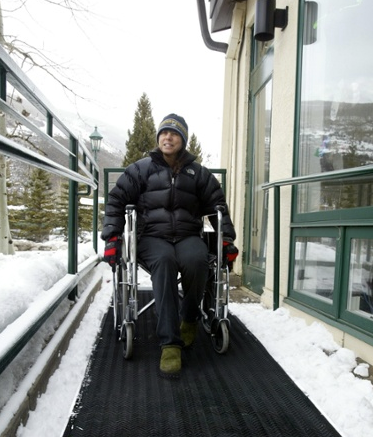 Efficiently managing industrial facilities is a task that is never so challenging as in the midst of the winter season. Snow and ice removal must be handled in a fast, effective manner that keeps your building constantly accessible to all. Not only must your premises be safe and functional, they must also fully comply with the high standards of the Americans with Disabilities Act (ADA).
Efficiently managing industrial facilities is a task that is never so challenging as in the midst of the winter season. Snow and ice removal must be handled in a fast, effective manner that keeps your building constantly accessible to all. Not only must your premises be safe and functional, they must also fully comply with the high standards of the Americans with Disabilities Act (ADA).
ADA Snow-Removal Regulations
There is only one basic principle underlying all ADA snow-removal regulations - facilities must be readily accessible to everyone, regardless of their physical condition. The impacts of this principle are many and varied, affecting every part of your property on which people walk or drive.
Some of the most important ADA snow-removal rules include:
-
Snow and ice must be completely cleared from parking spaces, immediately surrounding areas, and all walking aisles. Curb ramps must also be cleared, and snow can never be piled up in handicapped parking spaces.
-
Sidewalks and walkways must be constantly accessible, only brief and isolated interruptions being permissible.
-
All entrances and exits must be snow-free, allowing safe and easy access to the building.
-
"Reasonable snow-removal efforts" must be conducted in a timely manner. Access must be restored as soon as possible, and if delay is inevitable, a temporary alternate access route must be established.
ADA's Regulatory Impacts
The DOJ takes enforcement of "equal access" very seriously, and businesses cannot afford to risk an expensive, time-consuming court battle. Your company does not wish to put pedestrians at risk of slip-and-fall injuries nor itself at risk of lawsuits. Therefore, an ADA compliance plan is essential, and it will involve the following business impacts:
-
Snow plows and other equipment must be purchased, maintained, and stored.
-
Salt and sand must be stockpiled and distributed across your facility as needed.
-
Personnel must be assigned to handle the snow-removal.
-
Significant funds must be budgeted to cover the costs of ADA compliance.
Alternative ADA Compliance Solutions
Some aspects of ADA compliance, such as clearing off parking lots, may require traditional methods. Viable alternatives, however, exist for other aspects such as ice elimination and entryway accessibility.
Instead of using salt and sand to prevent icing on cleared-off areas, another option is liquid brine. This salt-and-water mixture does require the purchase of a brine maker, but it also minimizes salt-damage to your concrete and steel infrastructure.
High-traffic entryways can be made safer and easier to manage by use of heated, snow-melting mats on both walkways and stairways. The mats consist of a heating element sandwiched between two layers of slip-proof rubber. Surface patterns ensure grip and traction, and the mats are self-grounded and compatible with standard 120 and 240 volt outlets
ADA snow-removal compliance presents a genuine challenge to managers of industrial facilities, and businesses must expend significant time and money to meet these requirements. Alternative methods, like liquid brine and heated, snow-melting mats, often work more efficiently than surface salting, and it is well worth investigating how effective such new solutions might be at your facility.


